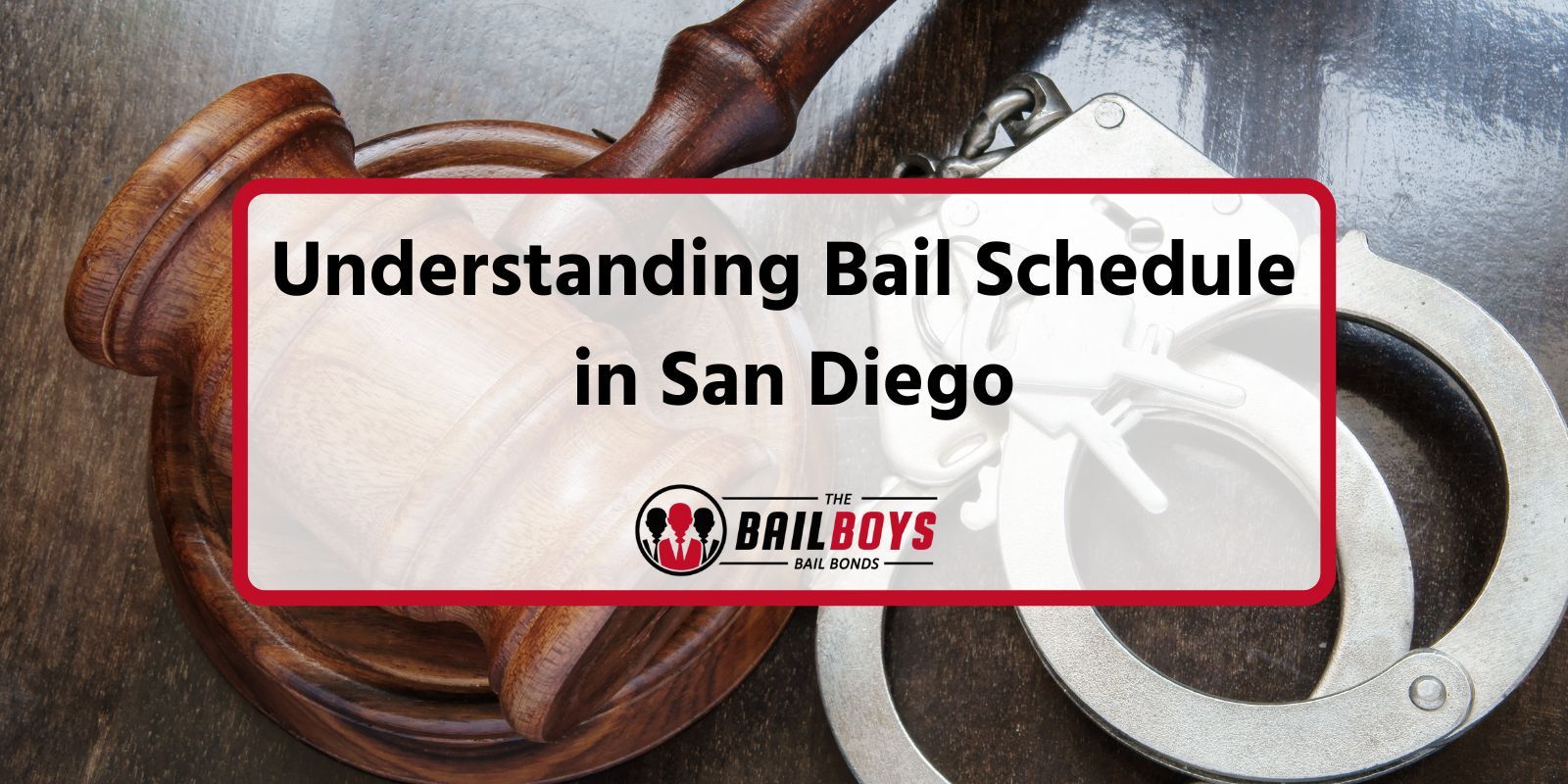
Understanding Bail Schedule in San Diego
The United States bail system allows suspects accused of a crime to be released before trial by paying cash, property, or through a bail bond provided by a bail bondsman. The bail schedule is a set of guidelines that helps judges determine the amount of bail to set for various offenses. The bail schedule is typically structured to reflect the severity and nature of the alleged crime.
Understanding the bail schedule in San Diego County will help you make more informed decisions about your legal strategy.
If you’re looking to understand the cost of bail in San Diego, come talk to our team of professional bail bondsmen at The Bail Boys. With over 20 years of experience in the bail bond industry, we can help you understand everything about the bail schedule in San Diego. Contact us now to get the expert guidance you need.
As you read on, you’re going to learn what a bail schedule is, why it is important, and the key factors influencing bail amounts in San Diego County.
What is a Bail Schedule?
A bail schedule refers to a preset list that specifies bail amounts for various offenses. It serves as a guide for determining the bail amount for defendants to pay for their release from detention while awaiting trial.
Bail schedule includes a wide range of different crimes, from misdemeanors to more serious felonies. Each crime category attracts a specific bail amount, depending on its severity. Hence, individuals on bail are assigned to pay bail following the bail schedule, providing a systematic framework for bail determination.
However, the use of bail schedules depends on the jurisdiction. While some jurisdictions employ predetermined bail amounts, others may permit judicial discretion to vary based on the uniqueness of a case. To understand the local amounts for different offenses, it’s essential to refer to the bail schedule San Diego County uses.
Importance of Bail Schedules in the Judicial Process
Not all jurisdictions use bail schedules. Still, this legal document is helpful in many ways, including;
- Standardizing the judicial process: Essentially, bail schedules streamline the bail process, giving judges a quick and consistent approach to determining bail amount.
- Transparency: Bail schedules promote transparency in the legal system, offering defendants and legal professionals a clear picture of the expected bail amount for specific offenses.
- Judicial Discretion: Bail schedules serve as guides for judges. In cases where judicial discretion is allowed, judges may use bail schedules as a starting point and adjust the amounts based on the nature and severity of the case.
Overview of the San Diego Bail Schedule
The San Diego bail schedule is a detailed document establishing scheduled bail amounts for various offenses within the jurisdiction of San Diego County. It’s a vital element of San Diego’s legal system, influencing the pre-trial release process. The bail amounts are determined by a majority vote in the Superior Court of San Diego County.
Most offenses in San Diego have certain bail amounts attached by statute, which means the majority of defendants can gain their freedom before a hearing.
San Diego’s bail schedule differs from bail schedules in other California counties in different ways. For instance, given the larger population of Los Angeles County, the scheduled bail amounts for similar offenses in San Diego and Los Angeles may differ due to variations in local policies and considerations. The bail schedule in Riverside County may consider local factors, such as crime rates and demographics.
Factors Affecting Bail Amounts in San Diego
- The nature and severity of the offense
- Criminal history: individuals with a prior criminal record may face higher ball amounts
- The level of potential threat your release poses to public safety
- Any aggravating factors
- The flight risk
- Defendant’s financial capacity
- Community ties
Examples of Different Bail Amounts for Various Offenses in San Diego County
- Battery — $8,000 or $10,000 for a second offense.
- Assault with a firearm — $20,000.
- Rape — $100,000.
- Receiving stolen property valued at or less than $950 — $2,000.
- Vandalism results in $400 or less of damage — $2,000.
- Stalking — $20,000, and the amount doubles with each subsequent conviction.
- Unlawful possession of firearm or ammunition — $10,000.
- Refusal to obey peace officer — $5,000.
- Possession of marijuana on school grounds — $500.
- Driving with a suspended license — Depending on the reason for the suspension, between $150 and $5,000.
- Hit and run causing injury — $10,000.
When an individual is facing multiple charges, they will have to pay the sum of the bail for all of the charges against them. In the judicial system, this is often referred to as bail stacking.
Navigating the Bail Process in San Diego: A Step-by-Step Guide
Below is a step-by-step guide for navigating the bail process in San Diego.
Step 1: Arrest and Booking
Following an arrest, the individual is booked into the county jail, and the charges are processed.
Step 2: Initial Court Appearance
The defendant makes an initial court appearance on a scheduled court date, and the judge determines bail based on factors like the severity of the charges and the defendant’s criminal history.
Step 3: Bail Determination
The judge sets a bail amount, and the defendant has the option to post bail by paying the full amount in cash or seek alternative methods like a bail bond.
Step 4: Understanding Bail Options
There are different bail options to consider such as
- Cash Bail: Paying the full bail amount directly to the court.
- Bail Bonds: Seeking assistance from a bail bondsman to post a bond for a percentage of the total bail.
Step 5: Hiring a Bail Bondsman
If you need to post bail through a bail agent, find a reputable bail bondsman in San Diego. Bail agencies post the bail on behalf of the defendant. They typically charge a non-refundable fee, usually a percentage of the posted bail amount (usually 10%).
Step 6: Application and Approval
Complete the necessary paperwork with the bail bondsman, providing personal and financial information. The bondsman assesses the risk and decides whether to approve the bond.
Step 7: Posting the Bond
Once approved, the bondsman posts the bail bond with the court, securing the defendant’s release.
Step 8: Release from Custody
The defendant is released from custody, pending trial, upon successful posting of bail.
Step 9: Adherence to Legal Obligations
The defendant is expected to adhere to all court-mandated requirements, including attending all scheduled court hearings.
Step 10: Conclusion of Legal Proceedings
The bail process ends with the resolution of the legal case. If the defendant complies with all court orders, the bail amount is typically returned, excluding any applicable fees.
The Role of Legal Counsel in the Bail Process
Legal counsel plays a significant role throughout the bail process, offering guidance, expertise, and advocacy. Attorneys review the situation and offer counsel on the likelihood of bail, and the best approach for securing a favorable outcome. They help clients understand their rights, potential consequences, and the overall legal process, helping them to make informed decisions.
Local bar associations often provide directories of reputable attorneys, enabling individuals to find legal professionals with expertise in criminal law and the bail process.
Also, legal aid organizations in San Diego offer assistance to those who cannot afford private representation. Furthermore, community outreach programs and public defender services contribute to the availability of legal assistance for individuals facing the complexities of the bail process.
Recent Changes and Updates to the Bail Schedule in San Diego
San Diego’s legal landscape is not static. There are regular adjustments to the County’s bail schedule in the form of legal reforms, changes in public policy, or growing societal perspectives on criminal justice.
In May 2022, the San Diego County Sheriff’s Department announced the end of the zero bail policy instituted during the pandemic. The zero bail policy was a policy that reduced certain minor misdemeanors to zero bail throughout the San Diego County jail system. It was instituted to reduce the overall jail population and curb the spread of the COVID-19 pandemic.
However, in May 2022, the policy was rescinded, meaning that those offenses that qualified for zero bail will have predetermined bail amounts imposed again. These bail amounts will be based on those outlined in the San Diego Superior Court Bail Schedule.
This recent change has impacted both defendants and the broader legal system. For defendants, people in the lower economic class who may not afford the bail amounts will have to stay in custody pending trials. This can disrupt an individual’s entire life, especially when hearing is delayed.
This change may also impact the overall efforts to address concerns related to unfairness in the justice system. The courts must consider an individual’s capacity to pay, as well as the danger of release when considering bail.
Conclusion
Bail schedules in San Diego outline the bail amounts for various offenses in the jurisdiction, from misdemeanors to grievous crimes. Although sometimes adjustable, they give judges a head start to decide what a defendant should pay, while helping to streamline the judicial process.
At The Bail Boys, we offer several payment options and will help you find the right one that will fit into your budget. To serve you better, we have locations all over Southern California and we are available 24/7. Contact us now to secure your bail bond as







